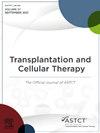A Tender Reduced-Intensity Conditioning for the Unfit: A Novel 4 Gy Total Body Irradiation-Based Conditioning Followed by Two-Step Haploidentical Stem Cell Transplant, Results of a Prospective Trial
IF 3.6
3区 医学
Q2 HEMATOLOGY
引用次数: 0
Abstract
Allogeneic hematopoietic stem cell transplant (HSCT) remains the only potentially curative treatment for many hematologic malignancies (HM). We previously developed a two-step approach that separates the lymphoid and myeloid portions of the graft, allowing a consistent T cell dosing and sparing the stem cells from the effect of post-transplant cyclophosphamide (CY). The two-step approach demonstrated safety and efficacy in patients treated with myeloablative and reduced-intensity conditioning. Here, we extended our two-step platform to older and less fit patients and explored the effects of using a high dose of T cells on disease relapse and transplant outcomes. Thirty-four patients with HM were treated. Median age was 68 years old and included a minority population constituting 32%. Eighty-two percent had a hematopoietic cell transplantation comorbidity index score ≥3. Ninety-one percent were haploidentical, and the rest were matched-related donor HSCT. Following administration of fludarabine and 2 Gy total body irradiation (TBI) (13 patients) or 4 Gy TBI (21 patients) conditioning regimen, a fixed dose of 2 × 108/kg CD3+ T cells was given, followed 2 days later by CY, then infusion of CD34-selected stem cells. Overall survival (OS) was 70% at 1 year and 48% at 3 years. The cumulative incidence (CI) of non-relapse mortality (NRM) and relapse were 22% and 33% at 3 years. However, the CI of relapse was much lower for patients treated with 4 Gy TBI versus those treated with 2 Gy TBI (11% versus 54%, P = .045), while NRM was similar (23% versus 15%, P = .399). This contributed to a high OS of 64% in patients who received 4 Gy TBI-based conditioning at 3 years, with median OS not reached, although this was not statistically significant (P = .68). The median time to neutrophil and platelet recovery was 12 and 17 days, respectively. The CI of grade II acute graft-versus-host-disease (aGVHD) was 22% and 26% at 100 days and 6 months, respectively. The CI of chronic GVHD (cGVHD) was 7.5% at 3 years. There was no grade III or IV aGVHD, no severe cGVHD, and no deaths attributable to GVHD. In conclusion, the two-step approach HSCT demonstrated a low disease relapse rate and high survival in patients treated with 4 Gy TBI-based conditioning, despite a generally older and more medically compromised patient population.
为不适合者提供柔韧的 RIC:一项前瞻性试验的结果:基于 4 Gy TBI 的新型调理,然后进行两步式单倍体干细胞移植。
异基因造血干细胞移植(HSCT)仍然是许多血液系统恶性肿瘤(HM)唯一可能治愈的治疗方法。我们之前开发了一种两步法,将移植物的淋巴细胞和髓细胞部分分开,使T细胞剂量保持一致,并使干细胞免受移植后环磷酰胺(PTCY)的影响。两步法在接受髓内消融和降低强度调理治疗的患者中显示出安全性和有效性。在这里,我们将两步法平台扩展到年龄较大、体质较差的患者,并探索了使用高剂量T细胞对疾病复发和移植结果的影响。34名HM患者接受了治疗。中位年龄为68岁,少数民族占32%。82%的患者造血细胞移植综合指数(HCT-CI)评分≥3。91%为单倍体(HI),其余为匹配的亲缘供者造血干细胞移植。在使用氟达拉滨和2 Gy全身照射(13名患者)或4 Gy全身照射(21名患者)调理方案后,给予固定剂量的2×108/kg CD3+ T细胞,2天后使用环磷酰胺,然后输注CD34筛选干细胞。1年总生存率为70%,3年总生存率为48%。3年后,非复发死亡率(NRM)和复发的累积发生率(CI)分别为22%和33%。然而,接受 4 Gy TBI 治疗的患者的复发 CI 远低于接受 2 Gy TBI 治疗的患者(11% vs 54%,p = 0.045),而非复发死亡率则相似(23% vs 15%,p = 0.399)。这使得接受基于 4 Gy TBI 治疗的患者在 3 年后的总生存率(OS)高达 64%,中位 OS 未达到,但无统计学意义(p = 0.68)。中性粒细胞和血小板恢复的中位时间分别为 12 天和 17 天。在100天和6个月时,II级急性移植物抗宿主病(aGVHD)的CI分别为22%和26%。3年后,慢性移植物抗宿主疾病(cGVHD)的CI为7.5%。没有III级或IV级aGVHD,没有严重的cGVHD,也没有因GVHD导致的死亡。总之,两步法造血干细胞移植显示,尽管患者年龄普遍较大、病情较重,但采用基于4 Gy TBI的调理方法治疗的患者疾病复发率低、存活率高。
本文章由计算机程序翻译,如有差异,请以英文原文为准。
求助全文
约1分钟内获得全文
求助全文
来源期刊

Transplantation and Cellular Therapy
Medicine-Hematology
CiteScore
7.00
自引率
15.60%
发文量
1061
审稿时长
51 days
 求助内容:
求助内容: 应助结果提醒方式:
应助结果提醒方式:


